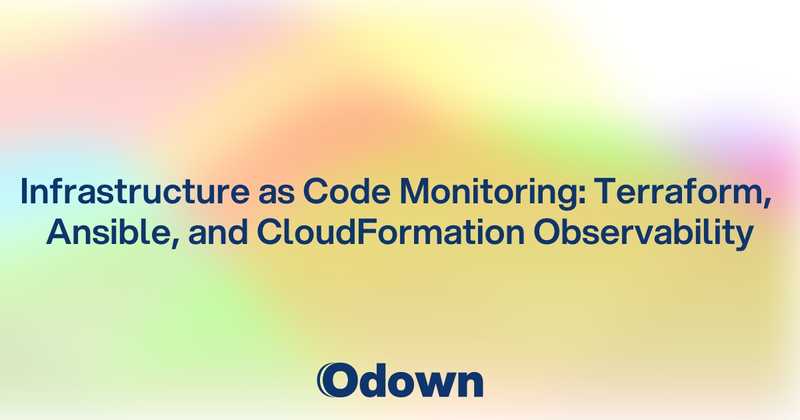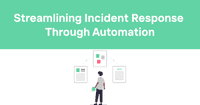Infrastructure as Code Monitoring: Terraform, Ansible, and CloudFormation Observability
Your production infrastructure just drifted from its intended state, and you have no idea when it happened or what changed. A critical server got manually modified, security groups were altered, or someone deployed resources without following your Infrastructure as Code (IaC) processes. By the time you notice, the damage is done.
This scenario plays out in companies every day because they treat IaC like a deployment tool instead of a living system that needs continuous monitoring. You wouldn't deploy an application without monitoring it, so why would you deploy infrastructure without the same level of observability?
Infrastructure as Code monitoring goes beyond checking if your deployments succeeded. It involves tracking configuration drift, monitoring compliance violations, detecting unauthorized changes, and ensuring your infrastructure remains in its intended state over time. Comprehensive monitoring solutions help you maintain infrastructure reliability just like they protect your applications.
The stakes are enormous when infrastructure monitoring fails. Security vulnerabilities can go undetected, costs can spiral out of control, and compliance violations can result in serious legal consequences. This guide shows you how to implement proper IaC monitoring that protects your infrastructure investments and maintains operational excellence.
IaC Monitoring Strategies: Version Control and Change Detection
Traditional infrastructure monitoring focuses on resource health metrics like CPU usage and disk space. IaC monitoring requires a completely different approach that tracks the relationship between your declared configuration and actual infrastructure state.
Version Control Integration for Infrastructure Changes
Your infrastructure configuration should be as carefully tracked as your application code. Every change needs to be auditable, reviewable, and reversible:
Git-based change tracking provides a complete history of infrastructure modifications. When something breaks, you can quickly identify what changed and when it happened. Tag your infrastructure releases just like you tag application releases to create clear rollback points.
Automated change validation catches configuration errors before they reach your infrastructure. Use pre-commit hooks and automated testing to verify syntax, check for security issues, and validate resource configurations against your organizational policies.
Change approval workflows ensure that infrastructure modifications go through proper review processes. Different types of changes might require different approval levels---a simple configuration update might only need peer review, while major architectural changes might require security team approval.
Drift Detection Beyond Basic Monitoring
Infrastructure drift happens when the actual state of your resources differs from what your IaC templates define. This can occur through manual changes, automated scaling, or external factors:
Configuration drift detection compares your live infrastructure against your IaC definitions to identify discrepancies. Some drift might be acceptable (like auto-scaling adjustments), while other drift indicates serious problems that need immediate attention.
Security drift monitoring specifically tracks changes that could impact your security posture. Unauthorized security group modifications, IAM policy changes, or encryption setting alterations should trigger immediate alerts.
Resource lifecycle monitoring tracks the entire lifecycle of infrastructure resources from creation to deletion. This helps you identify orphaned resources that consume costs without providing value.
Change Impact Analysis
Understanding how infrastructure changes affect your overall system helps you make better decisions and anticipate potential problems:
Dependency mapping shows how changes to one resource might affect other parts of your infrastructure. Modifying a network configuration could impact multiple applications, and your monitoring should track these relationships.
Blast radius calculation helps you understand the potential impact of infrastructure changes before you make them. This information is crucial for planning maintenance windows and change rollback procedures.
Cross-environment consistency monitoring ensures that your infrastructure remains consistent across development, staging, and production environments. Configuration differences between environments often cause deployment failures and unexpected behavior.
Terraform State Monitoring: Drift Detection and Compliance Tracking
Terraform state files contain the source of truth for your infrastructure, but they're also a single point of failure that needs careful monitoring. State file corruption, inconsistencies, or unauthorized modifications can cause serious operational problems.
State File Health and Integrity
Terraform state files are critical infrastructure components that deserve the same monitoring attention as your databases:
State file backup monitoring ensures your state files are properly backed up and recoverable. Test your backup and restore procedures regularly---discovering that your backups are corrupted during an emergency is too late.
State lock monitoring tracks when state files are locked and by whom. Long-running locks might indicate stuck operations or processes that need intervention.
State file size and complexity monitoring helps you identify when your Terraform configurations are becoming unwieldy. Extremely large state files can cause performance problems and increase the risk of errors.
Terraform Plan Monitoring and Analysis
The output from terraform plan contains valuable information about intended changes that should be monitored and analyzed:
Plan change analysis categorizes proposed changes by risk level. Adding new resources is usually low risk, while modifying or destroying critical resources requires more careful consideration.
Resource dependency tracking identifies when changes to one resource will force changes to dependent resources. These cascading changes can have unexpected consequences that need careful monitoring.
Plan execution time monitoring helps you identify when your Terraform operations are taking longer than expected. Slow plan operations might indicate provider API issues, network problems, or configuration complexity that needs attention.
Terraform Provider and Module Monitoring
Terraform relies on providers and modules that can change over time, potentially affecting your infrastructure:
Provider version monitoring tracks which provider versions you're using and alerts you to new releases that might affect your infrastructure. Major provider updates sometimes include breaking changes that require configuration updates.
Module dependency monitoring tracks the external modules your configurations depend on and monitors them for updates or security issues. Pinning module versions provides stability but means you need to actively monitor for updates.
Provider API health monitoring tracks the health and performance of the cloud provider APIs that Terraform uses. Provider outages or performance problems can affect your ability to manage infrastructure.
Ansible Playbook Monitoring: Execution Tracking and Error Detection
Ansible playbooks automate complex configuration management tasks, but their execution needs monitoring to ensure they're working correctly and not causing unintended side effects.
Playbook Execution Monitoring
Ansible playbook runs should be monitored like any other critical operational process:
Execution time tracking helps you identify when playbooks are taking longer than expected. Slow playbook execution might indicate target system problems, network issues, or inefficient playbook design.
Task-level monitoring breaks down playbook execution to identify which specific tasks are failing or taking excessive time. This granular information helps you troubleshoot problems more effectively.
Idempotency validation ensures that your playbooks truly are idempotent and don't make unnecessary changes when run multiple times. Non-idempotent playbooks can cause configuration drift and unexpected system behavior.
Ansible Inventory and Configuration Monitoring
Your Ansible inventory and configuration files define what systems get configured and how, making them critical components that need monitoring:
Inventory accuracy monitoring verifies that your inventory reflects the actual state of your infrastructure. Outdated inventory information can cause playbooks to miss systems or attempt to configure non-existent resources.
Configuration template monitoring tracks changes to Jinja2 templates and other configuration files that your playbooks deploy. Template syntax errors or logic mistakes can cause widespread configuration problems.
Variable and secret management monitoring ensures that sensitive information is properly encrypted and that variable values are consistent across different environments.
Ansible Target System Health
The systems that Ansible configures need monitoring to ensure they remain in their intended state after playbook execution:
Configuration persistence monitoring verifies that changes made by Ansible playbooks persist over time. Some configurations might be overwritten by other processes or reset during system restarts.
Service state monitoring tracks the status of services that Ansible manages. A service might start successfully during playbook execution but fail later due to configuration issues.
File and permission monitoring ensures that files deployed by Ansible maintain their intended permissions and ownership. Security issues often arise from incorrect file permissions that develop over time.
CloudFormation Stack Monitoring: Resource Health and Cost Optimization
AWS CloudFormation stacks represent complete infrastructure deployments that need comprehensive monitoring to ensure they remain healthy, secure, and cost-effective over time.
Stack State and Event Monitoring
CloudFormation stacks have complex lifecycles that require careful monitoring throughout their operational lifetime:
Stack status monitoring tracks the overall health of your CloudFormation stacks and alerts you to stacks that are in failed or inconsistent states. Failed stacks might leave resources in unexpected configurations that need manual cleanup.
Stack event monitoring provides detailed information about resource creation, modification, and deletion activities within your stacks. This information is crucial for troubleshooting deployment failures and understanding change impacts.
Rollback monitoring tracks when CloudFormation automatically rolls back failed deployments and helps you understand why deployments are failing. Frequent rollbacks might indicate configuration problems or resource conflicts.
Resource-Level Health Monitoring
Individual resources within CloudFormation stacks need monitoring to ensure they're functioning correctly:
Resource drift detection identifies when AWS resources have been modified outside of CloudFormation. Manual changes to CloudFormation-managed resources can cause stack updates to fail or behave unexpectedly.
Resource performance monitoring tracks the performance and health of individual resources within your stacks. A CloudFormation stack might deploy successfully but contain resources that aren't performing optimally.
Resource tagging compliance monitoring ensures that all resources created by CloudFormation stacks include the required tags for cost allocation, environment identification, and governance purposes.
Cost Optimization and Financial Monitoring
CloudFormation stacks can incur significant costs that need careful monitoring and optimization:
Stack cost tracking provides visibility into how much each CloudFormation stack costs to run. This information helps you identify opportunities for cost optimization and ensures you're not paying for unnecessary resources.
Resource utilization monitoring identifies underutilized resources within your stacks that might be candidates for downsizing or elimination. Right-sizing your infrastructure based on actual usage patterns can result in significant cost savings.
Reserved instance and savings plan alignment monitoring ensures that your CloudFormation stacks are taking advantage of available cost optimization programs. Misaligned resource types can result in paying on-demand prices when reserved pricing is available.
Proper infrastructure monitoring requires tools that can handle the complexity of modern IaC environments. API monitoring implementation strategies provide the foundation for monitoring the APIs that your infrastructure automation tools depend on.
Ready to implement comprehensive Infrastructure as Code monitoring? Use Odown and gain the observability tools you need to maintain reliable, secure, and cost-effective infrastructure deployments.



